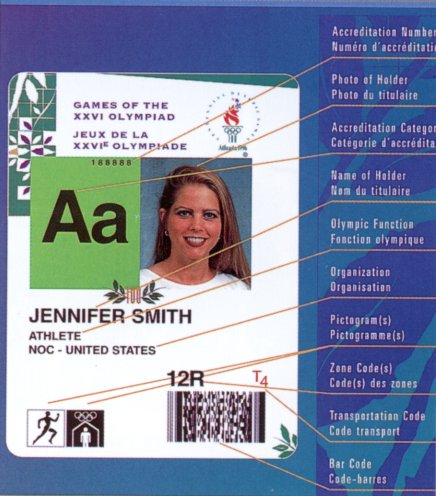Identity Card
POLICY The Olympic Charter dictates that only those with an official role or function necessary to stage the Games are eligible for accreditation. Eligible persons are identified as Olympic Family and non-Olympic Family. The IOC's Accreditation Guide defines Olympic eligibility. Based on this guide, individuals are identified under a large number of different accreditation categories. The Policy division determined and implemented access rights for all
constituent groups. It also identified, registered, and processed all individuals
requiring accreditation following approved policies and procedures. The
Policy division was primarily concerned with three areas: Additionally, the Policy division formulated regulations regarding zoning,
the OIC, the Olympic accreditation badge, the radio-frequency (RF) badge,
and the accreditation process. Zoning In order to regulate and control circulation within Olympic venues, each competition venue was divided into public areas accessible to all, including ticketed spectators, and areas reserved for accredited persons only. The latter areas were divided into zones that were restricted to persons with a functional need to be present. Accreditation staff met with management and site designers for each venue to develop a logical zoning plan based on a generic set of zones of exclusion. The zones had the same generic definition at all competition venues.
- 0 all zones The Olympic Villages were divided into two zones: the international
zone and the residential zone. Right to access the international zone was
indicated by zone code V, and zone code R granted access to both the international
and residential zones. Zoning principles were applied consistently to venue
perimeters and interiors. The concept of accredited circulation or flow
(zone 7) between restricted islands (zones 1-6) was broadly applied. Sport-
and venue-specific considerations played an important role in developing
zoning plans. Pictogram and zone signage was developed in conjunction with
each scheme. The Olympic Identity Card The OIC authorized Olympic Family members to enter the US to perform their Olympic duties during the Games. The OIC contained the holder's Olympic ID number, a personal identifier used to access the holder's record in the accreditation database promptly. In 1993, ACOG began to develop OIC policies and procedures in conjunction with US government representatives. Most matters were addressed by either the State Department or INS, but a number of other governmental services were also involved, including the US Department of Justice, Department of Labor, Federal Bureau of Investigation (FBI), Department of the Treasury, and the White House. While over a dozen different visa classifications for Olympic Family members would normally be issued, after lengthy discussions, it was agreed that the OIC would replace all necessary visa classifications except for the A visa issued to foreign diplomats. In spring 1995, operating procedures for the OIC were finalized, and it was agreed that the applicants' passports would not need to be submitted. However, in order to maintain their physical integrity, each OIC had to be submitted to the appropriate US consular post for approval and application of a tamper-resistant Centennial Seal. When designing the OIC, ACOG used the IOC Accreditation Guide, which contains baseline requirements for information displayed on the cards. In addition, ACOG worked closely with the Forensic Document Laboratory of the INS to develop specifications for the OIC that would safeguard against counterfeiting, alteration, and photo substitution. Prior to the Games, Accreditation focused on educating and establishing communication with NOCs and other organizations regarding the NOC process. ACOG personnel met with government officials in Washington, DC, and at the busiest ports of entry to explain the OIC process and answer questions. ACOG and the State Department also produced a video explaining the OIC process that was delivered to all US ports of entry and consular posts. A communication network encompassing ACOG personnel, senior State Department and INS officials, and the Olympic coordinators at US consular posts worldwide was also established. As a result, the majority of issues were resolved within 48 hours. To address entry problems during Gamestime, an ACOG representative coordinated the international entry response team (IERT), comprised of field officers from government agencies and ACOG personnel. Operational 24 hours daily during June and July, the IERT resolved any issues that arose during the Games period, particularly at ports of entry. 
Olympic Accreditation Badge The final goal of the accreditation process was delivering to authorized individuals accreditation badges that identified them and visually displayed their specific access rights and privileges. A basic principle of Olympic accreditation is that each eligible participant may be issued only one badge. Dual or multiple applications must be individually analyzed and consolidated, where appropriate. The accreditation category and the badge holder's name, photograph, function, and organization appeared on the accreditation badge. Access rights were represented by pictograms indicating sports, competition venues, and noncompetition venues where access control was enforced, and symbols for zone codes and transportation privileges. For the Atlanta Games, 84 pictograms were used-31 sports and 53 service pictograms-as well as 7 zone code and 5 transportation code symbols. Inside venues, an accredited person's ability to circulate within and access restricted areas was determined by numerical codes for zones as noted earlier. A transportation code was displayed next to the zone code on each badge.
The codes were as follows. (Source Document: Official Report 1996, Vol I,
page 54 - 55 ) |